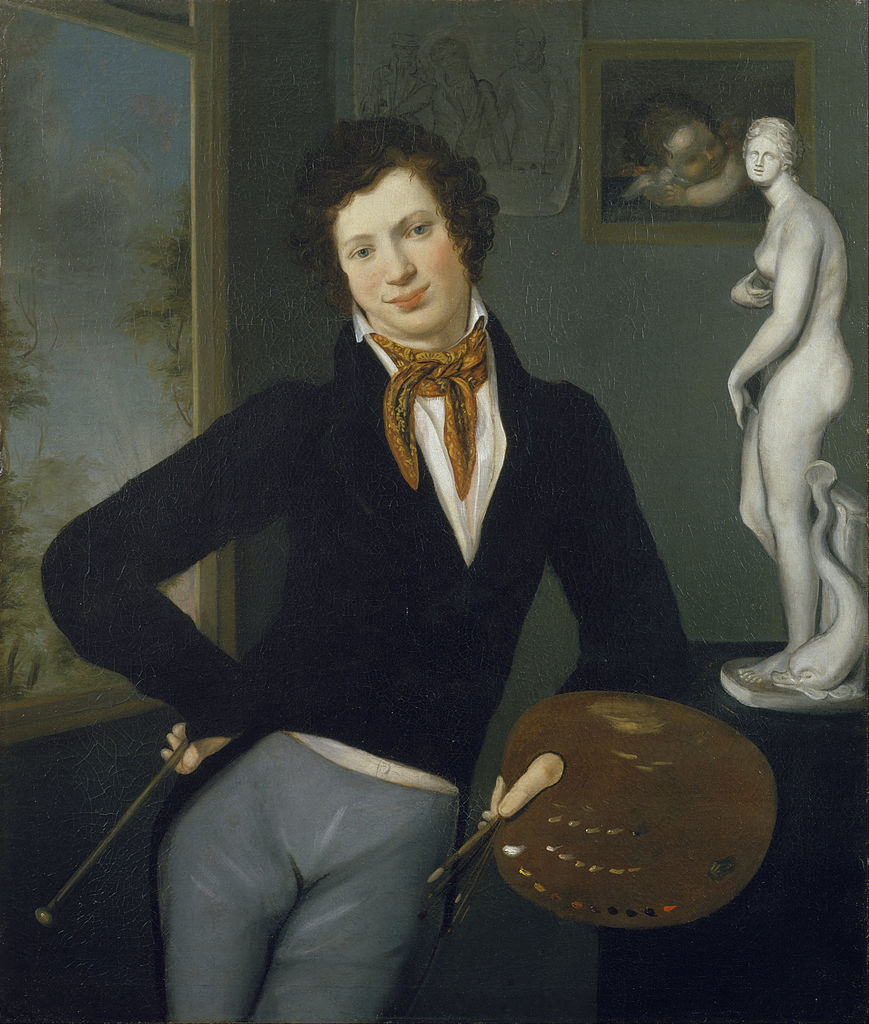
Moritz Daniel Oppenheim, Self-Portrait, 1814–16 (The Jewish Museum, New York). A self portrait of Moritz Daniel Oppenheim, the first Jewish painter to gain recognition in non-Jewish German society. By representing himself alongside a plaster cast of an ancient Greek sculpture and an oil sketch of a cherub resembling a painting by the Italian Renaissance artist Raphael, he portrays himself as an academically trained artist, an opportunity unavailable to Jews prior to the Enlightenment.
The emancipation of European Jews from ghettos became a benchmark of sorts indicating a nation’s transformation from the medieval to the modern. Upon the formation of a secular nation, French Jews received civil rights in 1791 and 1792. Other European nations followed throughout the 19th century. National communities distanced themselves from old forms of Christianity, and they tolerated Jews, albeit with reservations.
Jewish enlightenment (Haskalah)
In Germany, which did not become a unified nation until 1871, Jews were not granted full equality. Rights depended on local municipalities and in some places, Jews were awarded rights only to have them taken away soon after. It is no coincidence that Germany was the birthplace of Reform Judaism. Progressive thinkers sought to transform Judaism from within when they could not stem prejudice against Jews from without.
Moses Mendelssohn pioneered the Jewish Enlightenment, or Haskalah, which advocated many of the same ideas about freedom and equal rights as those that Jean-Jacques Rousseau and Immanuel Kant explored. Mendelssohn openly discussed the ways that Jews could live in a multi-religious society. “Adopt the mores and constitution of the country in which you find yourself,” he wrote, “but be steadfast in upholding the religion of your fathers, too.” [1] In subsequent generations, many Jews—among them, Karl Marx’s parents—found it easier simply to convert to Christianity and live publicly as Christians in order to access jobs, property, and other basic rights.
Reform movement
But there was another answer to the paradox posed by modernity. Inspired by Mendelssohn, Jewish questioners throughout German-speaking lands in the early nineteenth century developed the Reform movement. These reformers believed that their mission was to bring Judaism in line with modern thought; they also promoted the idea that prayers should be chanted in the local language rather than in Hebrew. They encouraged rabbis to look beyond the Talmud and Torah for guidance. Reformers spurned the idea that the past could dictate a way of life in an increasingly secular and industrial context. They modeled many of their religious practices after German Christians encouraging “decorum” in synagogue, introducing music similar to that heard in churches, and many even wanted to switch the Sabbath to Sunday. They wanted to remain Jews, while highlighting Judaism’s similarities with Christianity.
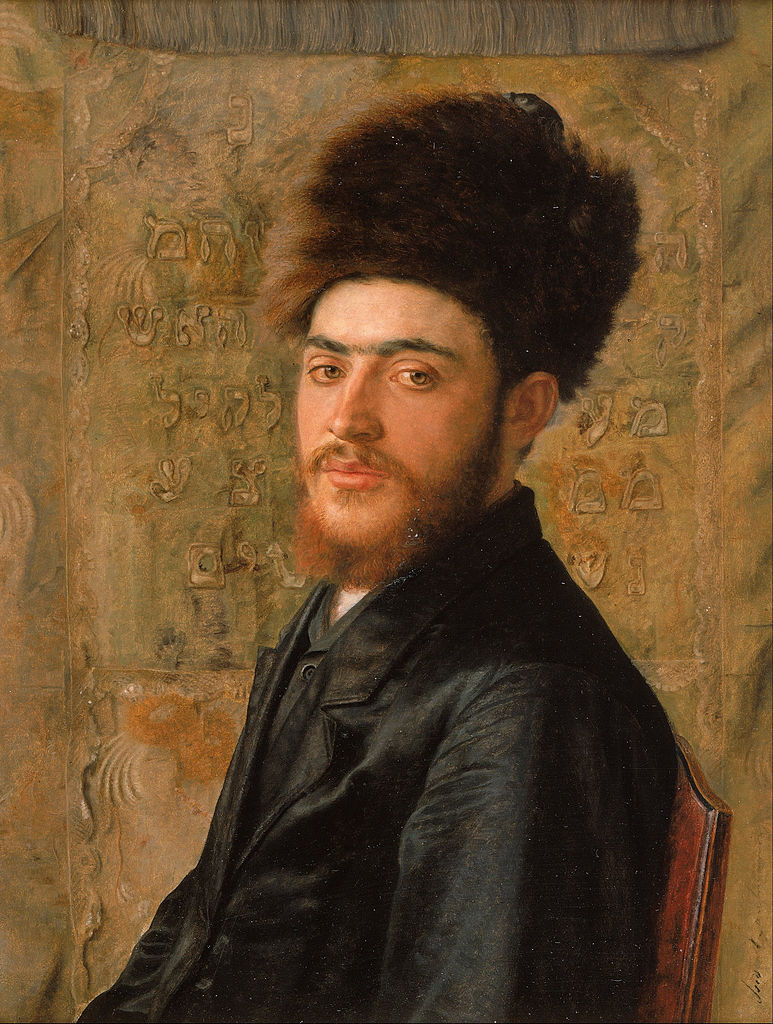
Isidor Kaufmann, Man with Fur Hat, c. 1910, Vienna, “Kaufmann’s portraits of religiously devout Jews conveyed aspects of Jewish tradition that his audience of acculturated Jews and non-Jews would understand. Here, the sitter’s orthodoxy is indicated by his fur-trimmed shtraymel (hat) and black kapote (coat). Hung in well-appointed parlors….they…provided a connection to Jewish heritage by linking the world of cosmopolitan Vienna to a traditional lifestyle that endured outside the capital.” (The Jewish Museum, New York)
Orthodox movement
These efforts infuriated traditionalists, who then reacted with steadfast conservatism. Some traditional rabbis had long opposed emancipation, but in response to the Reformers, a group of adherents to Halakhah codified the new Orthodox movement. They opposed many of the secular cultural forms that Judaism took in the coming decades: the Yiddishist movement, Zionism, and any other divergences from strict Halakhah. Some insisted that established customs not grounded in Jewish law should take on the weight of Halakhah—this is why some groups continue to dress and speak like their ancestors from a century ago or more. These extreme forms of observance are as much a product of modernity as Reform.
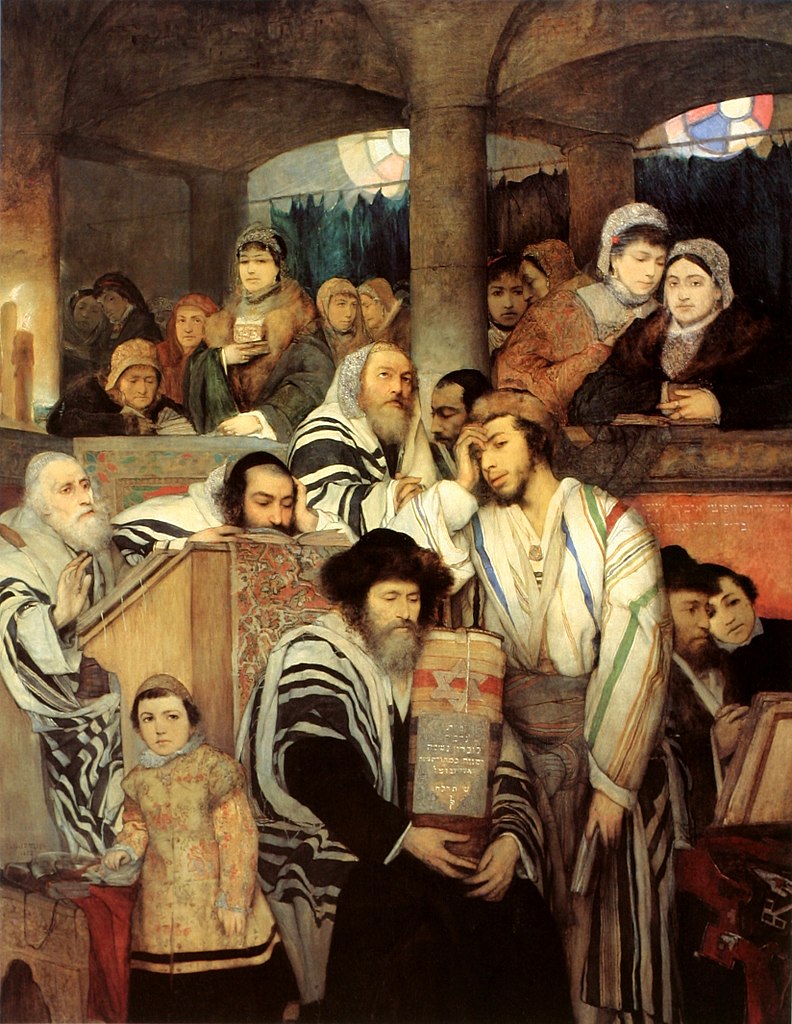
Maurycy Gottlieb, Jews Praying in the Synagogue on Yom Kippur, 1878, oil on canvas, 245.1 x 191.8 cm (Tel Aviv Museum of Art)
Hasidic Judaism
In Eastern Europe, another religious movement, called Hasidism, gained traction parallel to Reform and Orthodoxy. Founded in the eighteenth century by a rabbi and mystic who called himself Israel Baal Shem Tov, Hasidic Judaism grew out of a populist reaction to the elitism of the traditional Talmudic academy. Hasidic Judaism focuses on mystical interpretations of holy texts and the potential for uneducated Jews to experience holiness. The movement spread rapidly across Eastern and Central Europe. Hasidism gave rise to opposition from at least two sides: the traditional rabbinic legal structures that revolved around organized Torah study, and the “enlightened” Jews intent on both escaping the oppressive framework of the traditional Jewish family and acculturating into European society.
In spite of Hasidic Judaism’s strained history with what came to be known as Orthodoxy, it has become harder to distinguish stringent Orthodox Jews from their Hasidic counterparts. As Reform Judaism gained popularity, the two groups joined forces in support of Halakhah and in opposition to radical reform. Known for their distinctive dress (beards, fur hats, sidelocks, and caftans for men), Hasidim are among the most visible Jewish groups.
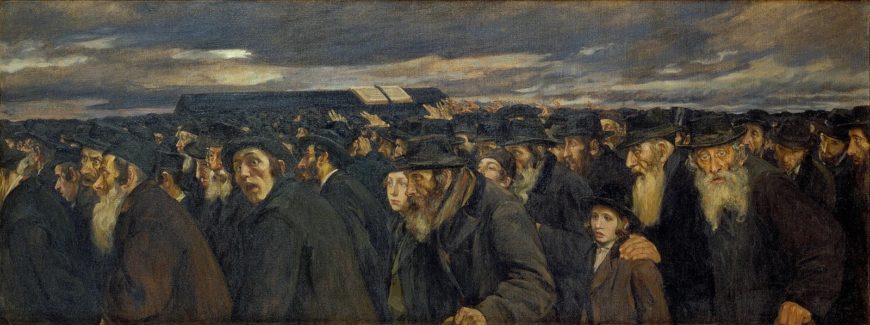
Samuel Hirszenberg, The Black Banner, 1905, oil on canvas (The Jewish Museum, New York) “Samuel Hirszenberg was one of the first artists to expose the plight of his fellow Jews in Russian-dominated Poland during the early years of the twentieth century. By the time he exhibited The Black Banner in the 1906 Salon of the Société des Artistes, he was established as a frequent participant in Paris-based exhibitions. Painted in 1905, The Black Banner evokes the intensified devastation felt by victims of pogroms at this time. Two terrified faces stare out at us; the one on the left may be the artist’s self-portrait. It has been suggested that the black banner covering the coffin is Hirszenberg’s means of decrying the Black Hundreds, the czarist-endorsed antisemetic bands who were so destructive during the pogroms of 1905–1906.”
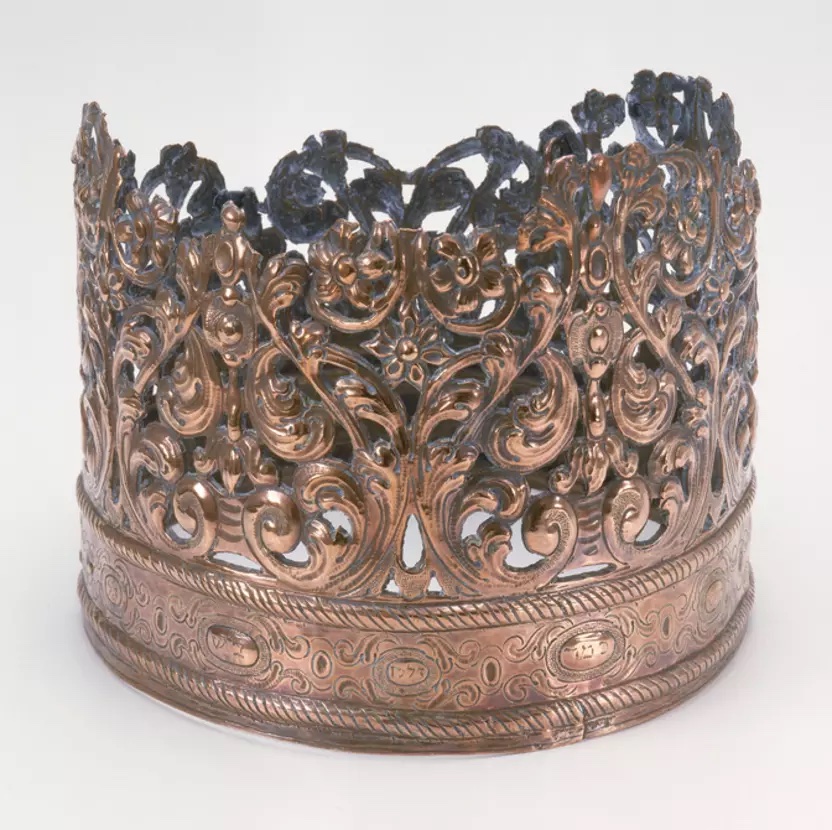
Torah Crown, 1698–99, Bolzano, Italy “Originally dedicated to an Italian synagogue in 1698/99, this crown was later plundered during a Russian pogrom and then recovered. It became part of the collection of the Great Synagogue of Danzig in the early 20th century. In 1939, it was sent to the Jewish Theological seminary in New York for safekeeping when the Nazis’ rise to power forced the Danzig Jewish community to disband.” (The Jewish Museum, New York)
Pogroms
Amidst political and economic turmoil in Western and Central Europe, nationalism became a rallying cry and pseudo-scientific ideas about race proliferated. A wave of antisemitism affected Jews within Europe and throughout the world in European colonies. From Russia to Damascus, and Danzig to Algiers, Jews were attacked as infiltrators and blamed for a wide range of social and economic problems. Accusations and rumors led to riots and pogroms (a Russian word that means to violently destroy, used to describe the riots in Eastern Europe in the 19th and early 20th centuries that resulted in the rape and murder of Jews and the theft and destruction of their property).
Zionism
Several events from the mid-nineteenth to the early twentieth centuries proved that Jews were not welcomed as equals. In Russia, violent pogroms and economic instability pushed over two million people to emigrate in the 1880s. The vast majority fled to North America, and a small fraction of pioneers traveled to Palestine, the site of ancient Judaism’s origins. Some Jewish leaders, responding to the growing nationalism and antisemitism of the late 19th and early 20th centuries, followed Theodor Herzl who advocated for a type of secular Jewish nationalism, a return to the biblical homeland of the Jewish people. Religious Jews had prayed facing Jerusalem and called for a Messianic return to the Land of Israel since the Second Temple was destroyed. But the modern political movement, known as Zionism, united the religious impulse to “return” with secular ideas about constructing a European-style nation for Jews. It is important to note that Zionism was but one form of Jewish nationalism that took hold in the nineteenth century. Some Jews fought for territorial and political autonomy on different parts of the globe, others fought for cultural autonomy in the nations where they lived. These Diaspora nationalist movements mostly disappeared in 1948 when Israel became an independent state.
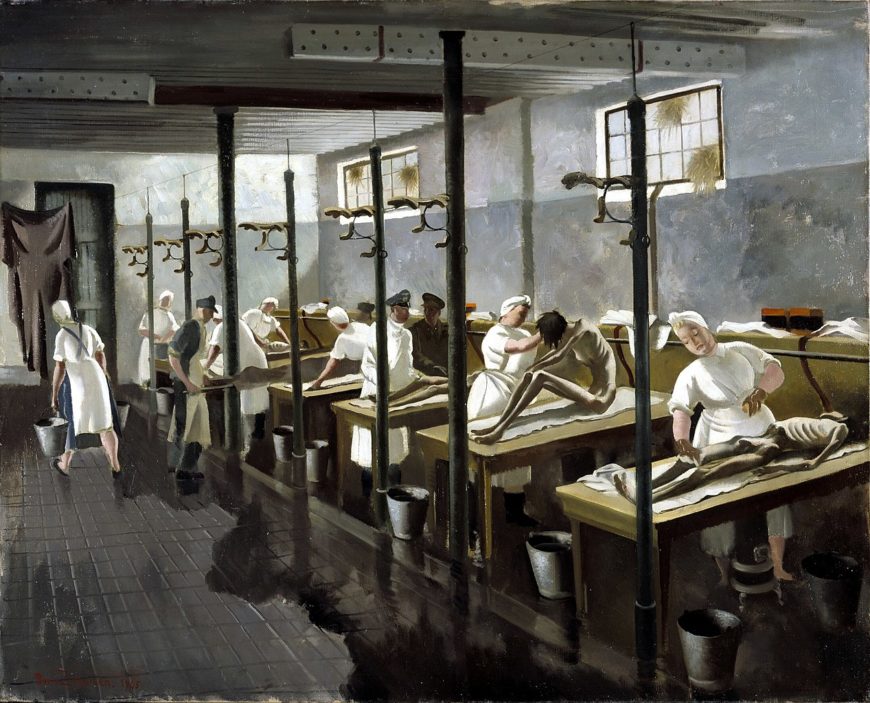
Doris Clare Zinkeisen, Human Laundry, Belsen: April 1945, “On 15 April 1945 British soldiers entered Bergen-Belsen concentration camp to find a scene of absolute horror. Ten thousand corpses lay unburied, and around 60,000 starving and sick people were packed into the camp’s barracks without food or water. Doris Zinkeisen arrived soon afterwards. Human Laundry is arguably the most powerful work produced by any of the artists who were present…. The camp inmates needed to be washed and de-loused to prevent the spread of typhus before they could be admitted to the makeshift Red Cross hospital nearby.” (Imperial War Museums)
Holocaust
“The antisemite creates the Jew,” wrote the French philosopher Jean-Paul Sartre in 1945. Antisemitism had generated a false image of what a Jew is, making Jews seem like a social danger for the majority of Europeans. After World War I, liberal democracies everywhere appeared to be failing. The idea that Jews were responsible for social and economic crises convinced many to use race and ethnicity as a test to determine who belonged and who ought to be excluded. It was in this climate that the Nazi party was elected to power in 1933. Combining their expansionist vision with spurious theories of racial purity, the Germans quickly came to control most of central and eastern Europe.
Genocide became an everyday phenomenon—the Nuremburg Laws forced Jews to identify themselves with a badge, and criminalized sexual intimacy between Jews and gentiles. Laws were passed across Europe and the Mediterranean that excluded Jews from certain professions and the right to attend school. Citizenship was revoked and many people were forced from their homes into overcrowded wards. Inspired by the medieval ghetto, the Nazis went further—killing Jews by restricting food and medicine, packing thousands into spaces fit for far fewer, and, eventually, forbidding Jews to leave at all. Working in collaboration with governments across Europe, Nazi officials enacted a “Final Solution” to the “Jewish Question” in early 1942. Jews were forcibly gathered and shipped to local concentration camps and to death camps in Poland and the USSR. Six million Jews died in the Holocaust.
Notes:
[1] Moses Mendelssohn, “19. Judaism and civil law,” Jerusalem: Religious Power and Judaism, 1783.
Additional resources
Ziva Amishai-Maisels, Depiction and Interpretation: The Influence of the Holocaust on the Visual Arts (New York, 1993).
Samantha Baskind and Larry Silver, eds., Jewish Art: A Modern History (London, 2011)
Barbara Kirshenblatt-Gimblett and Jonathan Karp, eds., The Art of Being Jewish in Modern Times (Philadelphia, 2008)
Vivian Mann and Richard Cohen, eds., From Court Jews to the Rothschilds: Art, Patronage, and Power, 1600–1800 (New York: Jewish Museum, 1996)
Catherine Soussloff, ed., Jewish Identity in Modern Art History (Berkeley, California, 1999)
Pierre Birnbaum and Ira Katznelson, eds., Paths of Emancipation: Jews, States, and Citizenship (Princeton: Princeton University Press, 1995).
Patrick Desbois, The Holocaust by Bullets: A Priest’s Journey to Uncover the Truth Behind the Murder of 1.5 Million Jews (Palgrave Macmillan, 2009)
Shmuel Feiner, The Jewish Enlightenment, translated by Chaya Naor (Philadelphia: University of Pennsylvania Press, 2004).
Zvi Y Gitelman, A Century of Ambivalence: the Jews of Russia and the Soviet Union, 1881 to the Present (New York: Schocken Books, 1988).
Deborah Hertz, How Jews Became Germans: The History of Conversion and Assimilation in Berlin (New Haven: Yale University Press, 2007).
Gershon Hundert, ed., Essential Papers on Hasidism: Origins to Present (New York: NewYork University Press, 1991).
Marion Kaplan, Between Dignity and Despair: Jewish Life in Nazi Germany (Oxford University Press, 1999).
Jacob Katz, Out of the Ghetto: the Social Background of Jewish Emancipation, 1770–1870 (Cambridge: Harvard University Press, 1973).
Michael Marrus and Robert Paxton, Vichy France and the Jews (Stanford University Press, 1995).
Michael Meyer, Response to Modernity: A History of the Reform Movement in Judaism (Oxford: Oxford University Press, 1988)
Ada Rapoport-Albert, ed. Hasidism Reappraised (Oxford: Littman Library of Jewish Civilization, 1998).
Jean-Paul Sartre, Anti-Semite and Jew, translated by George J. Becker (New York: Schocken Books, 1948).
Art Spiegelman, Meta Maus (New York: Pantheon Books, 2011).

